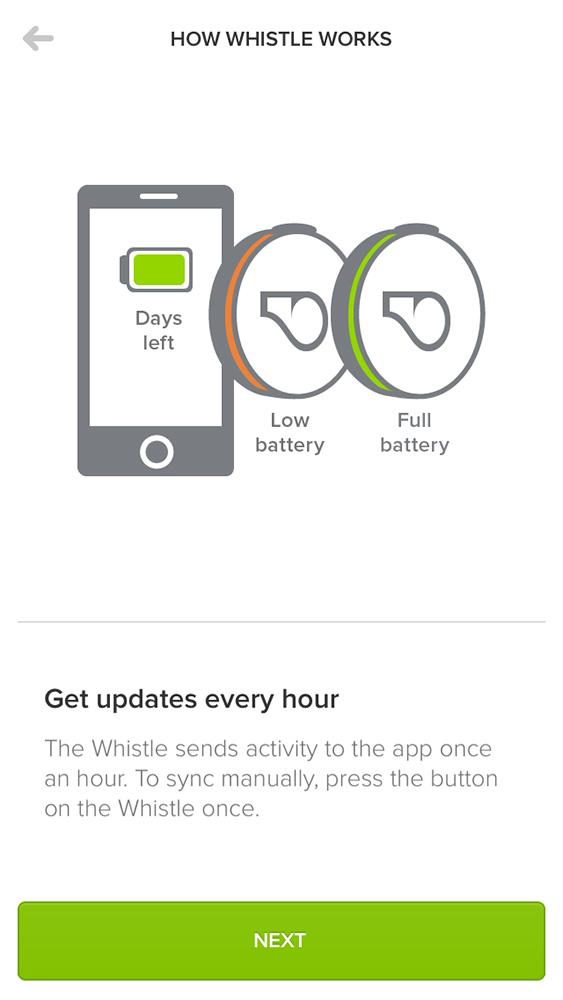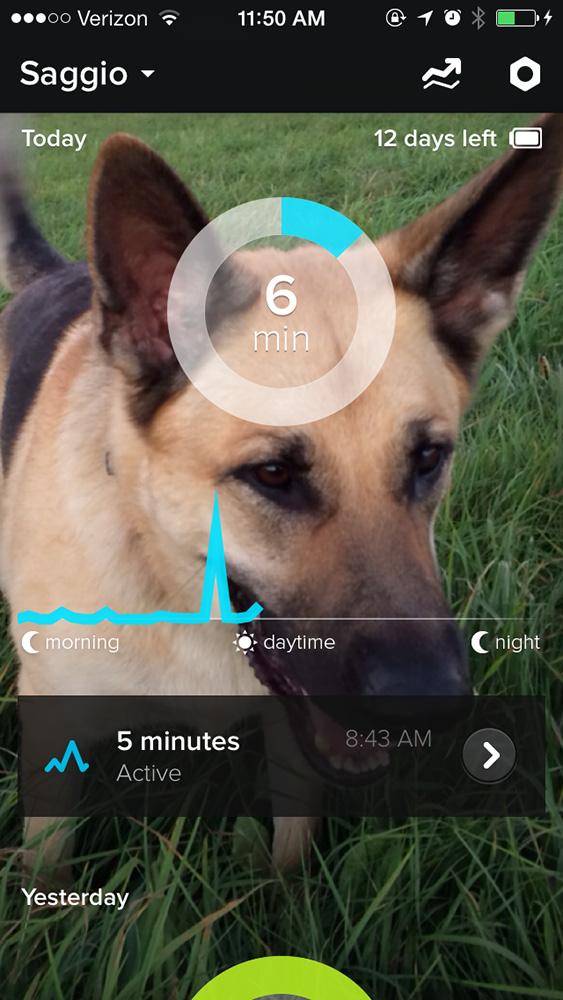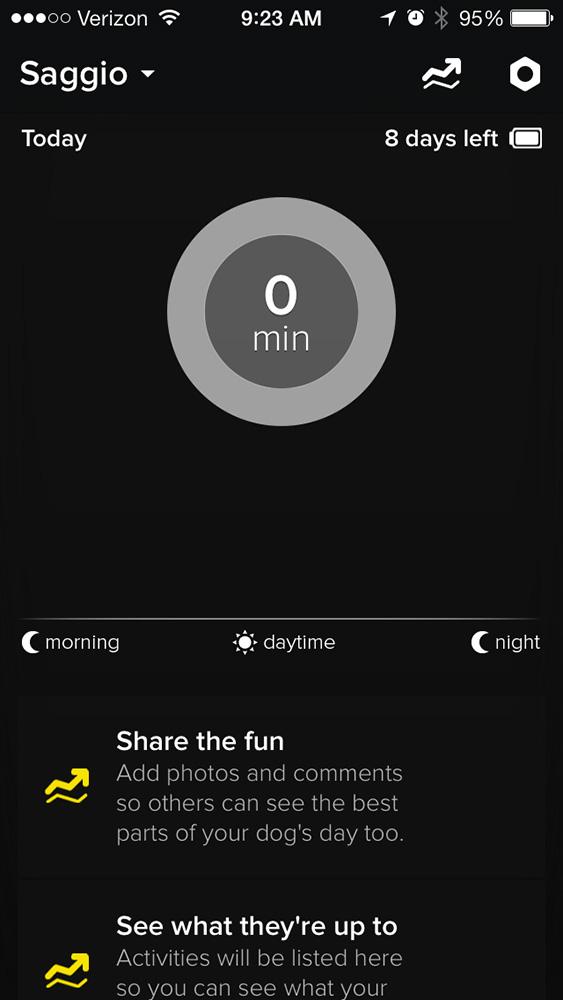
Is your dog getting enough exercise? If you’re like most dog owners, you’re not really around him all day to know. But thanks to a new breed of technology companies, understanding the needs of our furry best friends has become as simple as clipping a gadget on a collar and launching an app. And the latest of these pet-centric gadget makers is Whistle, creator of an elegant gizmo that keeps tabs on not only how much exercise Fido gets each day, but who he’s with and, eventually, a whole lot more. But with an increasing number of similar products on the market, is Whistle worth the $100 price tag? I went hands-on to find out.
Sit and look
Compact, light, and attractive, Whistle measures about as wide as a watch face and as thick as an iPhone. It weighs just 16 grams, making it appropriate for dogs 7 pounds or over, according to the company. On the neck of my 103-pound German Shepherd Saggio, it looks downright classy and almost futuristic, like a well-designed wristwatch (but for dogs). If you have a small dog, Whistle may look a bit large for his or her neck, but it’s otherwise easily the most attractive pet activity tracker on the market.
On the neck of my 103-pound German Shepherd Saggio, Whistle looks downright classy.
Whistle is made entirely with non-toxic chemicals, including stainless steel top and back caps, and durable black plastic sides – meaning your mongrel can chew hers up without necessarily needing a trip to the vet. It attaches to virtually any standard collar with an adjustable rubbery strap, which you leave on the collar at all times.
The device itself is locked on or removed to the plastic clasp that’s attached to the strap – though I found this was much easier to do when Saggio wasn’t moving, as it requires pressing in two buttons on the side of the base to release the Whistle, which is difficult to do when the dog is jaunting around with a stick in his mouth.
Rough and tumble tech
Whistle is designed to “go wherever your dog goes,” says Steven Eidelman, Whistle’s co-founder and head of product. Which means it needs to withstand some serious abuse. In addition to the tough shell, Whistle sports an IPX-7 waterproof rating, allowing it to stay submerged (in fresh water or saltwater) at depths up to 1 meter for as long as 30 minutes. Overkill? Yes – but that’s a heck of a lot better than needing to remove the Whistle every time your dog wants to take a dip. Saggio is a water hound, and runs to take a swim on my property’s pond every day. He also has a penchant for slathering himself in mud puddles any chance he gets. But not once during my time testing Whistle did the device show any signs of crapping out, rusting, or otherwise diminishing in look or function due to Saggio’s stress tests.

Inside, the Whistle packs a bevy of high-tech features you find in smartphones and fitness trackers for humans. A sensitive 3-axis accelerometer tracks your dog’s movements to a precise degree, allowing it to know exactly how much exercise or rest he’s getting throughout a given day. It also sports Bluetooth 4.0 (with both classic and low-power modes) for pairing with your smartphone, as well as Wi-Fi (802.11 b/g/n 2.4 GHz) for additional data-syncing and location-tracking purposes.
The Whistle’s lithium-ion polymer battery charges via USB, and can last up to seven days on a single charge, depending on how frequently you connect your smartphone to check up with Fido. Eidelman says the company toyed with the idea of real-time data updating, but that drains the battery too quickly. After updating four to five times a day over the course of a three-day test, however, I still haven’t re-charged the Whistle – so, not bad! When you do need to charge, it takes about one hour.
A circle of LED light emits from around the top cap. Different color lights tell you different things. A blue light, for example, means it is syncing with your handset via Bluetooth. Red means the battery is low. And green indicates a fully charged battery. You can check the status of the battery, initiate a Bluetooth sync, or reset the device entirely by pressing and holding the reset button located on the side of the Whistle.
Doggy app care
The Whistle device is but one half of the product. The app is where the data collected by your Whistle becomes information you can use.
After downloading it from the App Store, it’s easy to set up. You’ll be asked to create an account, or simply sign up using Facebook. I opted for the Facebook login, which created my account in about two seconds – easy.
As Whistle matures, I am confident that the already excellently designed device and app will only get better.
When you return to the Whistle app, you can connect the device to your Wi-Fi network, create a profile for your dog (which includes a photo, name, age, weight, gender, breed, and location) and set a daily exercise time goal for your dog. I set Saggio’s at 47 minutes because, why not? You can change the goal time later from the settings menu.
At the moment, Whistle’s sensitive accelerometer allows the device to categorize types of activity into a variety of categories, including walking, playing, and resting. Eidelman says they will soon add other types of activities, like swimming, scratching, barking, and even eating or drinking.
If you like, you can stop at this point and just start using Whistle to track how much exercise your dog packs in each day. Every time your dog gets some play time, Whistle collects that data, which is then displayed in the app after you reconnect to your Wi-Fi network. Each bit of exercise is represented on both a daily graph, as well as an automatically generated “event” in the day’s timeline. Each event can be tagged with a photo, and you can add comments, like “Saggio’s not feeling so well,” or whatever else you like. Each day’s activity level is then tracked over time, to give you a sense of how much exercise your pup really gets.
But Whistle doesn’t stop there. The app allows you to add multiple “owners,” this could be your husband or wife, your dog walker, or your pup’s trainer. You can also add multiple Wi-Fi networks, so your Whistle can upload more data into the app in more than one location. (In a forthcoming update, however, Whistle will be able to update via Bluetooth, so you won’t have to rely on a Wi-Fi connection, according to Eidelman.)
The app also lets you receive notifications for significant events, like meeting your daily goals. A battery status indicator tells you how much power is left in the device. And you can also see what percentage of the day your dog spends resting, and how his activity and resting levels compare to other Whistle-equipped dogs of the same age, breed, and size. You can also add multiple dogs, if you have more than one Whistle, or want to move the device from one dog to another.
Hard chew
For an entirely new product, I found that Whistle performed quite well. There were, however, a few glitches with the app. For example, setting up the Bluetooth connection is a bit of a pain – though that’s perhaps more Apple’s fault than Whistle’s. And it took a couple of days before Saggio’s activity stats showed up in the “Trends” category, where you can see your dog’s stats over time.
Whistle will go from being a nifty accessory that helps you get your dog the exercise he needs to one that could help save his life.
Also, Whistle’s reliance on Bluetooth, while handy, still requires you to hit the button on the device and reconnect it in your iPhone every time. This saves power, but I found it annoying. Update: After speaking with Eidelman again, I discovered that you only need to pair your Whistle with your iPhone once, during the initial set up. Everything else happens over Wi-Fi. So all those times I was pairing the Whistle were unnecessary, so scratch that from my list of complaints.
My primary complaint lies with Whistle’s attaching mechanism. The company clearly went to great lengths to make sure it doesn’t come off mid-fetch – because it’s extremely difficult to remove at all. I actually snapped off one of the two buttons on the collar clasp trying to remove the dang thing. Fortunately, Eidelman tells me they have replaced the version of clasp I tested with one made of a different kind of plastic that’s more durable, so that shouldn’t dissuade you from buying a Whistle. That said, getting the Whistle onto the charger was also a difficult, and I’m still not certain I understand how to do that properly.
One feature Whistle lacks is GPS tracking, which can be found in its competitor device, Tagg. For dogs who are prone to running off, that might be a deal breaker. But if, like Saggio, your dog sticks close by at all times, this isn’t a serious omission.
Last wag
As Whistle matures, I’m confident that the already excellently designed device and app will only get better. Annoying though it may be, the addition of Bluetooth data transfers will be welcome, especially for those of us who spend a lot of time outdoors with our pups. And the expansion of the accelerometer’s activity tracking will provide ample insight into how your dog is feeling – think about what you could know if you can see every time your dog eats, scratches, or barks. For healthcare purposes alone, this will be very valuable information.
In fact, Whistle is currently working with vets and pet pharmaceutical companies to incorporate the data it collects to help dog owners better care for their pets in a proactive rather than reactive way. When that day comes, Whistle will go from being a nifty accessory that helps you get your dog the exercise he needs to one that could help save his life.
Having access to your dog’s data is great – but it can also make you feel more stressed if you aren’t able to get him out to play as often as you would like. If you’re an obsessive dog owner, having a Whistle attached to your dog’s neck will only make you more so.
So, is it worth $100? Saggio, I’m sure, would say yes.
Whistle is currently available for pre-order purchase for $99.95 from Whistle.com, and will retail for $129.95 staring in 2014.









